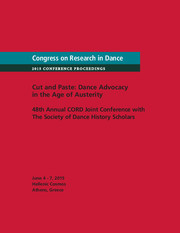No CrossRef data available.
Article contents
Moving with the Times: The Wellington New Dance Group
Published online by Cambridge University Press: 04 January 2013
Abstract
This paper explores the founding of the New Dance Group in Wellington, New Zealand, in 1945. The New Dance Group introduced radical ideas about dance, art, music, politics, and physical education to New Zealand. This paper examines the influence that American and European dance and physical education had on New Zealand's physical and artistic expression and places the introduction of modern dance within the social and cultural landscape of immediate the post—World War II period in New Zealand.
- Type
- Research Article
- Information
- Copyright
- Copyright © The Author(s) 2007


